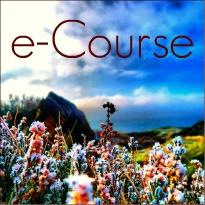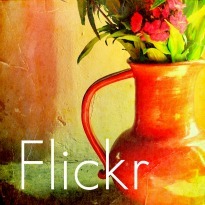The Joys of the Lime Green Kitchen
 Sunday, July 1, 2012 at 9:07 PM
Sunday, July 1, 2012 at 9:07 PM
It’s been three long years since I had a proper kitchen to play around in. And I’ve missed the gentle joy of time spent preparing food….the comfort of a well-stocked larder.
Now we’re back at Dixon Hill and there’s a beautiful new, lime green kitchen to potter about in. And I‘ve been pottering aplenty. Baking cakes whilst listening to Radio 4. Freezing tiny flowers in ice for pretty drinks all summer long.
The dehydrator has hummed while chunks of watermelon shrink to a toffeed stickiness. A jar of coconut kefir has gently fermented by the Aga. There’s been the thrice daily ritual of rinsing sprouting radish seeds. And the delicate scent of herbal teas cooling - to be sweetened and sharpened then frozen as ice lollies, ready for warmer days.
Next week, an elderflower bush has promised me a few perfect flower heads to make some kind of nectar. And little Kilner jars are waiting to be filled with a cultured tomato sauce.
I’m revelling in the slow, rhythmic rituals of the kitchen. The aromas and tastes. The whirring of the blender, the noise of the juicer. The feel of a knife in my hand as I chop and slice.
Right now, the lime green kitchen is my favourite place to be.
June – love it a little, loathe it a lot.
 Thursday, June 28, 2012 at 8:50 PM
Thursday, June 28, 2012 at 8:50 PM
I have a love/hate relationship with June. Actually, it’s far more of a hate relationship.
What I love is the burgeoning bloominess of it. August may be when the moors are at their most colourful, but I think I actually prefer the landscape round here in early June - when the fields sway with buttercups and the hedgerows froth white with cow parsley, hawthorn blossom and elderflowers.
All that frothing and flowering, however, produce oodles and oodles of pollen. And this is where I fall out of love with June. In a BIG way.
Since I was thirteen years old, I’ve suffered from chronically rotten hay fever (allergies). Nothing I’ve ever tried (antihistamines, homeopathic remedies, NAET therapy, eating local pollen etc. etc.) has ever made the slightest impact. Nothing, that is, except the steroids I was injected with throughout my teens (I swear I didn‘t know that‘s what they were!). They worked like magic but wrecked my immune system and devastated my health in massive fashion. Took me twenty years to get over that little lot. Not good.
So each year I suffer. Which is not a word I use lightly. But applicable here. It’s reached the point where, if I didn’t have my precious animals to consider, I would take off to the southern hemisphere for two months every year. Endure some extra winter, just to escape the pollen. It’s that gruesome. I hate to wish my life away but, at this point in the calendar, I’m always longing for the back end of July.
So, as pretty as it surely is, can’t say I’m sorry to say goodbye to month number six. Good riddance, June!
Changing Places: Carole Marie Gentry on Cuba
 Wednesday, June 27, 2012 at 2:24 PM
Wednesday, June 27, 2012 at 2:24 PM
I did not realize that revisiting a trip I took nine years ago would recall so many memories. Most of my photos were in pre-digital format, so it meant searching for photos in envelopes—bad, disorganized me—and some scan time. It also meant calling my sister in New York to ask her if she could cull her photography archives. The opposite of me; she is organized and immediately opened her beautiful photo album documenting our December 2003 trip to Cuba.
What was it about Cuba that made me fall deeply in love with her? Once I started looking at the photographs, I could not stop writing and my brain has been on hyper-drive. As we examined photographs and memories long ago tucked away, my sister and I have had many conversations about this trip, about Cubans, and about photography. What a time to reminisce about this moment in our lives!
The photographs told the story: the exhilarating and incredible moments, the difficult times (what trip doesn’t have them?), the beauty of the country, and the pulsating resiliency of the Cuban people themselves.
My love of photography was reignited during this trip. Although I had dabbled with photography when I was in high school and during my college years, I had never been a disciplined student of the medium. Not that I am serious now, but I derive great enjoyment spending time with my various cameras taking photos, particularly when I am on holiday.
What stories were the pictures telling me as I shuffled through our collective photographs? Initially, I recalled walking the streets of Havana on our first day. Our minds excited to explore the city and our bodies somewhat foggy and exhausted from jet lag and endless security checks in Miami and again, in Havana.
No matter what street or neighborhood we walked, we came upon block after block of exquisite, yet crumbling Spanish architecture that has been neglected for years almost ready to tumble into the sea. With no agenda in mind, we wandered serendipitously where our feet took us. The vibrant color of the city buildings was beautiful and the scent of sweet, tropical fruits and abundant flora permeated the air. Lively, rhythmic, Afro-Caribbean influenced jazz floated through the streets. The cool, salty sea breeze and the roar of ocean waves lapping up on shore drifted into our ears. It became clear that the combination of these elements and sensations evoke what the Cuban spirit embodies: a vivaciously rich appetite for life and a will to survive, to live life in full color.
Yet, against this dynamic backdrop, we could not ignore the extreme poverty around us. We encountered long queues for bread, fruit, produce and meat, as many shops’ shelves were barren. The poverty we witnessed tugged at our hearts; how could it not? We had packed clothing and gifts to give away, but there were many times we felt self-conscious taking out our cameras fully aware that they cost more than many Cubans’ annual income.
We met our friends Marisol, Berta and her beautiful baby girl in a plaza near our hotel. They would meet us several times during our stay, sometimes walking the entire city to meet us. At that time, cell phones and digital cameras had not proliferated the world, so our friends eagerly asked to have their pictures taken. Having photographs dotting the walls of our homes is not unusual but in places like Cuba, having the tangible evidence of a moment captured on paper is a luxury many people do not have. Having a photographic memory held in your hands is magical as it marks time, an occasion and the people surrounding you in the instant it is snapped. Photographs enable the viewer to float back in time, to re-experience beloved moments—they are visual vacations.
While some travelers consider the Spanish Colonial architecture, the music, the rum, the cigars and glimmering old 1950’s cars as the jewels of Cuba, for me, I would say it is the resiliency of the Cuban spirit that stands out in my mind. While economically deprived, Cuba does not have regrets or feel sorry for itself. Rightfully, Cubans are full of pride in their rich cultural, intellectual and artistic history. Most importantly, they command respect in their ability to survive with a joie de vivre that is remarkably buoyant, creative, beautiful and infectious. My photographs reminded me precisely why I fell in love with Cuba. I can’t wait to return someday!
When she’s not travelling, Carole divides her time between homes in Colorado and New Mexico. She’s a literary researcher, specialising in American and Native American literature. Find her blog here.
Changing Places is a guest post series about the power of place to change us. You can find other stories in the series here. If you’d like to share your own story, contact me for submission details.
Features of the Landscape: Sheep
 Tuesday, June 26, 2012 at 10:48 PM
Tuesday, June 26, 2012 at 10:48 PM
This is sheep country. And I love it. Love being surrounded by white woolly creatures. And black ones. And brown ones.
Some of my fondest memories of Dixon Hill revolve around sheep. Like nursing a tiny, sick lamb in front of the Aga on the day of a big family gathering (the visiting children thought the lamb had been laid on just for them and were enthralled!). Or bottle feeding three big, boisterous lambs, who would sneak out of their field when peckish and hurl themselves at the back door, all but breaking it down. Or standing in the road, halting the traffic (oh, the power!), whilst helping to move a flock to fresh grazing. Or simply sitting watching a few quiet creatures chew the cud whenever I’ve needed to regain perspective.
Wherever you stand on the hillside here, you can see sheep. They’re scattered across the fields and the fells. They endure the Pennine weather and survive on barren uplands that won’t support crops. The year cycles round with the ways of the shepherd: first tupping, then lambing, then clipping.
When we lived in the States, sheep were high on the list of things I most missed. Very high. I missed hearing the bleats and the baas. And nothing puts a bigger smile on my face than watching a gang of lambs play tag on a balmy spring evening.
So….sheep. Quite possibly my favourite feature of the landscape.






